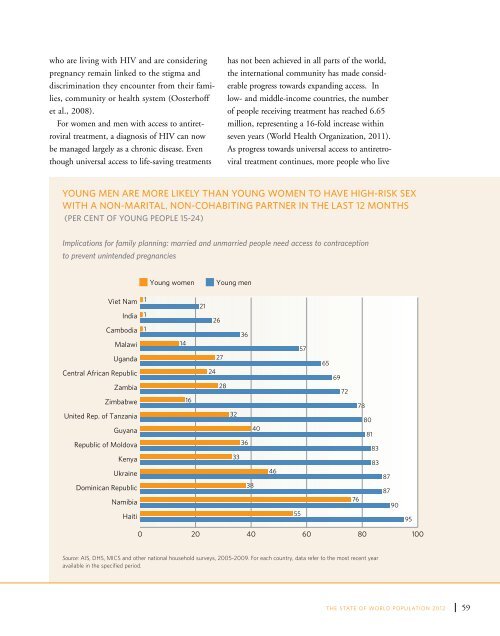State of World Population 2012 - Country Page List - UNFPA
State of World Population 2012 - Country Page List - UNFPA
State of World Population 2012 - Country Page List - UNFPA
Create successful ePaper yourself
Turn your PDF publications into a flip-book with our unique Google optimized e-Paper software.
who are living with HIV and are considering<br />
pregnancy remain linked to the stigma and<br />
discrimination they encounter from their families,<br />
community or health system (Oosterh<strong>of</strong>f<br />
et al., 2008).<br />
For women and men with access to antiretroviral<br />
treatment, a diagnosis <strong>of</strong> HIV can now<br />
be managed largely as a chronic disease. Even<br />
though universal access to life-saving treatments<br />
has not been achieved in all parts <strong>of</strong> the world,<br />
the international community has made considerable<br />
progress towards expanding access. In<br />
low- and middle-income countries, the number<br />
<strong>of</strong> people receiving treatment has reached 6.65<br />
million, representing a 16-fold increase within<br />
seven years (<strong>World</strong> Health Organization, 2011).<br />
As progress towards universal access to antiretroviral<br />
treatment continues, more people who live<br />
Young men are more likely than young women to have high-risk sex<br />
with a non-marital, non-cohabiting partner in the last 12 months<br />
(PER CENT <strong>of</strong> young people 15-24)<br />
Implications for family planning: married and unmarried people need access to contraception<br />
to prevent unintended pregnancies<br />
Young women<br />
Young men<br />
Viet Nam<br />
India<br />
Cambodia<br />
Malawi<br />
Uganda<br />
Central African Republic<br />
Zambia<br />
Zimbabwe<br />
United Rep. <strong>of</strong> Tanzania<br />
Guyana<br />
Republic <strong>of</strong> Moldova<br />
Kenya<br />
Ukraine<br />
Dominican Republic<br />
Namibia<br />
Haiti<br />
1<br />
1<br />
1<br />
14<br />
16<br />
21<br />
26<br />
27<br />
24<br />
28<br />
36<br />
32<br />
40<br />
36<br />
33<br />
38<br />
46<br />
55<br />
57<br />
65<br />
69<br />
72<br />
78<br />
80<br />
81<br />
83<br />
83<br />
76<br />
87<br />
87<br />
90<br />
95<br />
0 20 40 60 80<br />
100<br />
Source: AIS, DHS, MICS and other national household surveys, 2005-2009. For each country, data refer to the most recent year<br />
available in the specified period. <br />
THE STATE OF WORLD POPULATION <strong>2012</strong><br />
59
















